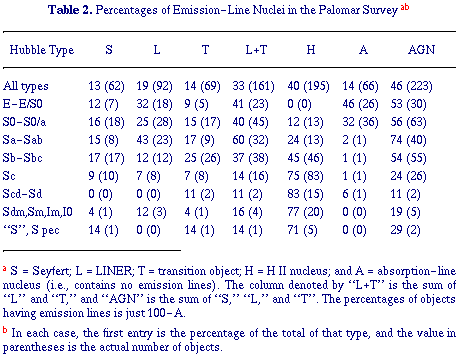


Although the specific numbers cited differ from one investigator to another,
all the older surveys discussed in Section 3
agree that LINERs are extremely
common in nearby galaxies. They also concur that the detection rate of LINERs
varies strongly with Hubble type, with early-type systems
being the preferred hosts; this result essentially confirms what was already
found by
Burbidge & Burbidge (1962),
who noted that most of the galaxies
showing enhanced [N II] / H ratios tended to be of early type.
ratios tended to be of early type.
Not surprisingly, the Palomar survey likewise finds the same trends. The important distinction, however, is that the results from the present survey are quantitatively much more reliable, for reasons already discussed in Section 4, both in a statistical sense as well as on an object-by-object basis. The detection rates of the various classes of emission-line nuclei defined in Section 2 are given in Table 2 and graphically illustrated in Figure 4a. The conclusions that can be drawn are the following.

 12.5 mag, the
vast majority of which (~ 80%) have early
Hubble types (E-Sbc). The fraction of galaxies hosting Seyfert nuclei has
roughly doubled compared to previous estimates
(Stauffer 1982b;
Keel 1983b;
Phillips, Charles, &
Baldwin 1983;
Maiolino & Rieke 1995).
It is interesting to note that Seyfert nuclei, at least with luminosities
as low as those here, do not exclusively reside in spirals, as is
usually believed (e.g.,
Adams 1977;
Weedman 1977).
In fact, galaxies of
types E and E/S0 have roughly the same probability of hosting a Seyfert
nucleus as those of types between S0 and Sbc.
12.5 mag, the
vast majority of which (~ 80%) have early
Hubble types (E-Sbc). The fraction of galaxies hosting Seyfert nuclei has
roughly doubled compared to previous estimates
(Stauffer 1982b;
Keel 1983b;
Phillips, Charles, &
Baldwin 1983;
Maiolino & Rieke 1995).
It is interesting to note that Seyfert nuclei, at least with luminosities
as low as those here, do not exclusively reside in spirals, as is
usually believed (e.g.,
Adams 1977;
Weedman 1977).
In fact, galaxies of
types E and E/S0 have roughly the same probability of hosting a Seyfert
nucleus as those of types between S0 and Sbc.
 104 K) ionized gas in
their centers. Although the dominant ionizing agent responsible for the
line emission is still controversial
(Binette et al. 1994,
and references
therein), our failure to detect spectra resembling ordinary metal-rich
H II regions among the ~ 60 ellipticals in our survey suggests that
young massive stars are probably not the culprit, unless the physical
conditions in the centers of ellipticals conspire to make H II regions
look very different from those seen in the nuclei of S0s and early-type
spirals.
104 K) ionized gas in
their centers. Although the dominant ionizing agent responsible for the
line emission is still controversial
(Binette et al. 1994,
and references
therein), our failure to detect spectra resembling ordinary metal-rich
H II regions among the ~ 60 ellipticals in our survey suggests that
young massive stars are probably not the culprit, unless the physical
conditions in the centers of ellipticals conspire to make H II regions
look very different from those seen in the nuclei of S0s and early-type
spirals.
Theoretical studies (e.g., Heller & Shlosman 1994) suggest that large-scale stellar bars can be highly effective in delivering gas to the central few hundred parsecs of a spiral galaxy, which may then lead to rapid star formation. Further instabilities may result in additional inflow to smaller physical scales relevant for AGNs. Thus, provided that a reservoir of gas exists, the presence of a bar might be expected to influence the fueling rate, and hence the activity level. Being sufficiently large and unbiased with respect to bar type, the Palomar survey can be used to examine this issue. Ho, Filippenko, & Sargent (1996a, e) find that the presence of a bar does indeed enhance both the probability and rate of the formation of massive stars in galaxy nuclei, but only for spirals with types earlier than Sbc. By contrast, AGNs seem to be altogether unaffected.